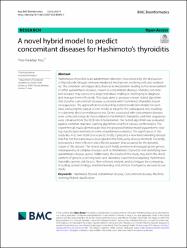| dc.contributor.author | Atas, Pinar Karadayi | |
| dc.date.accessioned | 2023-11-07T06:15:30Z | |
| dc.date.available | 2023-11-07T06:15:30Z | |
| dc.date.issued | 2023 | en_US |
| dc.identifier.citation | Ataş, P. K. (2023). A novel hybrid model to predict concomitant diseases for Hashimoto’s thyroiditis. BMC bioinformatics, 24(1), 319. | en_US |
| dc.identifier.issn | 14712105 | |
| dc.identifier.uri | https://doi.org/10.1186/s12859-023-05443-5 | |
| dc.identifier.uri | https://hdl.handle.net/20.500.12294/3963 | |
| dc.description.abstract | Hashimoto’s thyroiditis is an autoimmune disorder characterized by the destruction of thyroid cells through immune-mediated mechanisms involving cells and antibodies. The condition can trigger disturbances in metabolism, leading to the development of other autoimmune diseases, known as concomitant diseases. Multiple concomitant diseases may coexist in a single individual, making it challenging to diagnose and manage them effectively. This study aims to propose a novel hybrid algorithm that classifies concomitant diseases associated with Hashimoto’s thyroiditis based on sequences. The approach involves building distinct prediction models for each class and using the output of one model as input for the subsequent one, resulting in a dynamic decision-making process. Genes associated with concomitant diseases were collected alongside those related to Hashimoto’s thyroiditis, and their sequences were obtained from the NCBI site in fasta format. The hybrid algorithm was evaluated against common machine learning algorithms and their various combinations. The experimental results demonstrate that the proposed hybrid model outperforms existing classification methods in terms of performance metrics. The significance of this study lies in its two distinctive aspects. Firstly, it presents a new benchmarking dataset that has not been previously developed in this field, using diverse methods. Secondly, it proposes a more effective and efficient solution that accounts for the dynamic nature of the dataset. The hybrid approach holds promise in investigating the genetic heterogeneity of complex diseases such as Hashimoto’s thyroiditis and identifying new autoimmune disease genes. Additionally, the results of this study may aid in the development of genetic screening tools and laboratory experiments targeting Hashimoto’s thyroiditis genetic risk factors. New software, models, and techniques for computing, including systems biology, machine learning, and artificial intelligence, are used in our study. © 2023, BioMed Central Ltd., part of Springer Nature. | en_US |
| dc.language.iso | eng | en_US |
| dc.publisher | BioMed Central Ltd | en_US |
| dc.relation.ispartof | BMC Bioinformatics | en_US |
| dc.identifier.doi | 10.1186/s12859-023-05443-5 | en_US |
| dc.rights | info:eu-repo/semantics/openAccess | en_US |
| dc.subject | Autoimmun Disease | en_US |
| dc.subject | Concominant Disease | en_US |
| dc.subject | Hasimoto’s Thyroid | en_US |
| dc.subject | Hybrid Classification | en_US |
| dc.subject | Machine Learning | en_US |
| dc.title | A novel hybrid model to predict concomitant diseases for Hashimoto’s thyroiditis | en_US |
| dc.type | article | en_US |
| dc.department | İktisadi ve İdari Bilimler Fakültesi, Yönetim Bilişim Sistemleri Bölümü | en_US |
| dc.authorid | 0000-0003-0924-1196 | en_US |
| dc.identifier.volume | 24 | en_US |
| dc.identifier.issue | 1 | en_US |
| dc.relation.publicationcategory | Makale - Uluslararası Hakemli Dergi - Kurum Öğretim Elemanı | en_US |
| dc.institutionauthor | Atas, Pinar Karadayi | |
| dc.authorwosid | ABB-2911-2021 | en_US |
| dc.authorscopusid | 57190189556 | en_US |
| dc.identifier.wosquality | Q3 | en_US |
| dc.identifier.wos | WOS:001054298700002 | en_US |
| dc.identifier.scopus | 2-s2.0-85168656915 | en_US |
| dc.identifier.pmid | 37620755 | en_US |


















